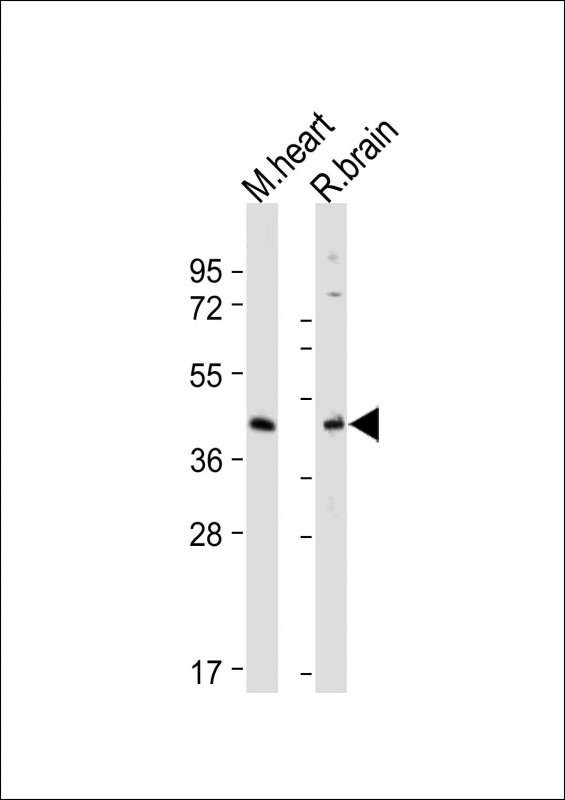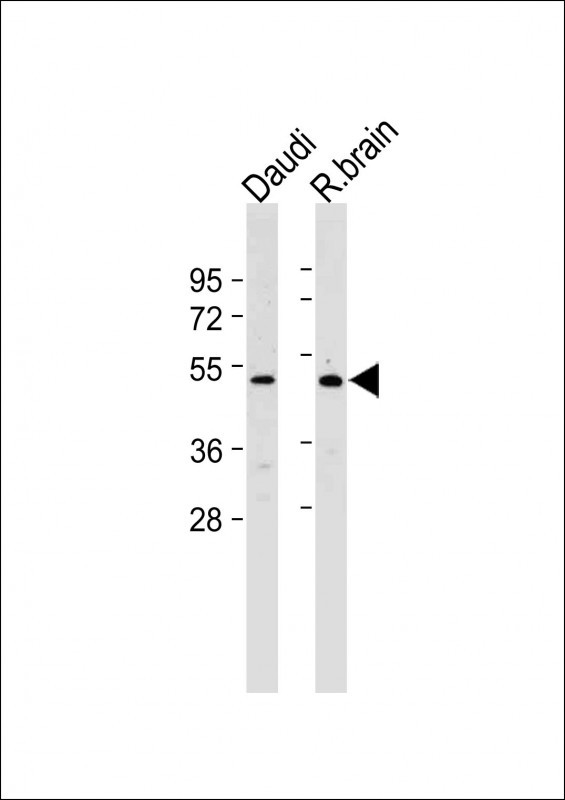GPER Antibody (C-term)
Affinity Purified Rabbit Polyclonal Antibody (Pab)
- SPECIFICATION
- CITATIONS: 1
- PROTOCOLS
- BACKGROUND

Application
| WB, E |
|---|---|
| Primary Accession | Q99527 |
| Other Accession | NP_001091671.1, NP_001496.1 |
| Reactivity | Human, Mouse, Rat |
| Host | Rabbit |
| Clonality | Polyclonal |
| Isotype | Rabbit IgG |
| Calculated MW | 42248 Da |
| Antigen Region | 346-375 aa |
| Gene ID | 2852 |
|---|---|
| Other Names | G-protein coupled estrogen receptor 1, Chemoattractant receptor-like 2, Flow-induced endothelial G-protein coupled receptor 1, FEG-1, G protein-coupled estrogen receptor 1, G-protein coupled receptor 30, GPCR-Br, IL8-related receptor DRY12, Lymphocyte-derived G-protein coupled receptor, LYGPR, Membrane estrogen receptor, mER, GPER1, CEPR, CMKRL2, DRY12, GPER, GPR30 |
| Target/Specificity | This GPER antibody is generated from rabbits immunized with a KLH conjugated synthetic peptide between 346-375 amino acids from the C-terminal region of human GPER. |
| Dilution | WB~~1:1000-2000 E~~Use at an assay dependent concentration. |
| Format | Purified polyclonal antibody supplied in PBS with 0.09% (W/V) sodium azide. This antibody is purified through a protein A column, followed by peptide affinity purification. |
| Storage | Maintain refrigerated at 2-8°C for up to 2 weeks. For long term storage store at -20°C in small aliquots to prevent freeze-thaw cycles. |
| Precautions | GPER Antibody (C-term) is for research use only and not for use in diagnostic or therapeutic procedures. |
| Name | GPER1 (HGNC:4485) |
|---|---|
| Function | G-protein coupled estrogen receptor that binds to 17-beta- estradiol (E2) with high affinity, leading to rapid and transient activation of numerous intracellular signaling pathways. Stimulates cAMP production, calcium mobilization and tyrosine kinase Src inducing the release of heparin-bound epidermal growth factor (HB-EGF) and subsequent transactivation of the epidermal growth factor receptor (EGFR), activating downstream signaling pathways such as PI3K/Akt and ERK/MAPK. Mediates pleiotropic functions among others in the cardiovascular, endocrine, reproductive, immune and central nervous systems. Has a role in cardioprotection by reducing cardiac hypertrophy and perivascular fibrosis in a RAMP3-dependent manner. Regulates arterial blood pressure by stimulating vasodilation and reducing vascular smooth muscle and microvascular endothelial cell proliferation. Plays a role in blood glucose homeostasis contributing to the insulin secretion response by pancreatic beta cells. Triggers mitochondrial apoptosis during pachytene spermatocyte differentiation. Stimulates uterine epithelial cell proliferation. Enhances uterine contractility in response to oxytocin. Contributes to thymic atrophy by inducing apoptosis. Attenuates TNF-mediated endothelial expression of leukocyte adhesion molecules. Promotes neuritogenesis in developing hippocampal neurons. Plays a role in acute neuroprotection against NMDA-induced excitotoxic neuronal death. Increases firing activity and intracellular calcium oscillations in luteinizing hormone-releasing hormone (LHRH) neurons. Inhibits early osteoblast proliferation at growth plate during skeletal development. Inhibits mature adipocyte differentiation and lipid accumulation. Involved in the recruitment of beta-arrestin 2 ARRB2 at the plasma membrane in epithelial cells. Also functions as a receptor for aldosterone mediating rapid regulation of vascular contractibility through the PI3K/ERK signaling pathway. Involved in cancer progression regulation. Stimulates cancer-associated fibroblast (CAF) proliferation by a rapid genomic response through the EGFR/ERK transduction pathway. Associated with EGFR, may act as a transcription factor activating growth regulatory genes (c-fos, cyclin D1). Promotes integrin alpha-5/beta-1 and fibronectin (FN) matrix assembly in breast cancer cells. |
| Cellular Location | Nucleus. Cytoplasm. Cytoplasm, perinuclear region. Cytoplasm, cytoskeleton. Cell membrane; Multi-pass membrane protein. Basolateral cell membrane; Multi-pass membrane protein. Cytoplasmic vesicle membrane; Multi-pass membrane protein Early endosome. Recycling endosome. Golgi apparatus membrane; Multi-pass membrane protein. Golgi apparatus, trans-Golgi network. Endoplasmic reticulum membrane; Multi-pass membrane protein. Cell projection, dendrite. Cell projection, dendritic spine membrane; Multi-pass membrane protein. Cell projection, axon. Postsynaptic density Mitochondrion membrane; Multi-pass membrane protein. Note=Colocalized with BSN to the active zone of presynaptic density. Colocalized with DLG4/PSD95 and neurabin-2 PPP1R9B in neuronal synaptosomes (By similarity). Endocytosed in a agonist- and arrestin-independent manner. Colocalized with RAMP3 and clathrin-coated pits at the plasma membrane. Colocalized with transferrin receptor at the plasma membrane and perinuclear region. Accumulated and colocalized with RAB11 proteins in recycling endosomes and trans-Golgi network (TGN), but does neither recycle back to the cell surface nor traffics to late endosome or lysosome. Colocalized with calnexin in the endoplasmic reticulum. Traffics to intracellular sites via cytokeratin intermediate filaments like KRT7 and KRT8 after constitutive endocytosis in epithelial cells. Colocalized with EGFR in the nucleus of agonist-induced cancer-associated fibroblasts (CAF). |
| Tissue Location | Expressed in placenta, endothelial and epithelial cells, non laboring and laboring term myometrium, fibroblasts and cancer-associated fibroblasts (CAF), prostate cancer cells and invasive adenocarcinoma (at protein level). Ubiquitously expressed, but is most abundant in placenta. In brain regions, expressed as a 2.8 kb transcript in basal forebrain, frontal cortex, thalamus, hippocampus, caudate and putamen. |

Provided below are standard protocols that you may find useful for product applications.
Background
This gene is a member of the G-protein coupled receptor 1 family and encodes a multi-pass membrane protein that localizes to the endoplasmic reticulum. The protein binds estrogen, resulting in intracellular calcium mobilization and synthesis of phosphatidylinositol 3,4,5-trisphosphate in the nucleus. This protein therefore plays a role in the rapid nongenomic signaling events widely observed following stimulation of cells and tissues with estrogen. Alternate transcriptional splice variants which encode the same protein have been characterized. [provided by RefSeq].
References
Patel, V.H., et al. Int. J. Mol. Med. 26(2):193-199(2010)
Ignatov, A., et al. Breast Cancer Res. Treat. 123(1):87-96(2010)
Li, Y., et al. Mol. Endocrinol. 24(5):969-980(2010)
Kang, L., et al. Mol. Endocrinol. 24(4):709-721(2010)
Ariazi, E.A., et al. Cancer Res. 70(3):1184-1194(2010)
If you have used an Abcepta product and would like to share how it has performed, please click on the "Submit Review" button and provide the requested information. Our staff will examine and post your review and contact you if needed.
If you have any additional inquiries please email technical services at tech@abcepta.com.














 Foundational characteristics of cancer include proliferation, angiogenesis, migration, evasion of apoptosis, and cellular immortality. Find key markers for these cellular processes and antibodies to detect them.
Foundational characteristics of cancer include proliferation, angiogenesis, migration, evasion of apoptosis, and cellular immortality. Find key markers for these cellular processes and antibodies to detect them. The SUMOplot™ Analysis Program predicts and scores sumoylation sites in your protein. SUMOylation is a post-translational modification involved in various cellular processes, such as nuclear-cytosolic transport, transcriptional regulation, apoptosis, protein stability, response to stress, and progression through the cell cycle.
The SUMOplot™ Analysis Program predicts and scores sumoylation sites in your protein. SUMOylation is a post-translational modification involved in various cellular processes, such as nuclear-cytosolic transport, transcriptional regulation, apoptosis, protein stability, response to stress, and progression through the cell cycle. The Autophagy Receptor Motif Plotter predicts and scores autophagy receptor binding sites in your protein. Identifying proteins connected to this pathway is critical to understanding the role of autophagy in physiological as well as pathological processes such as development, differentiation, neurodegenerative diseases, stress, infection, and cancer.
The Autophagy Receptor Motif Plotter predicts and scores autophagy receptor binding sites in your protein. Identifying proteins connected to this pathway is critical to understanding the role of autophagy in physiological as well as pathological processes such as development, differentiation, neurodegenerative diseases, stress, infection, and cancer.


